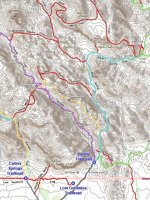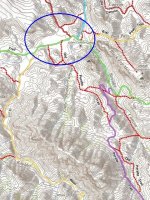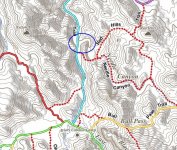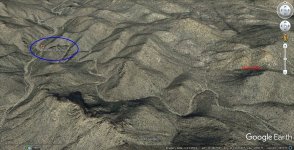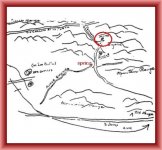skyhawk1251
Sr. Member
This discussion could end up being a very lengthy and convoluted thread, with a lot of "forks" as it moves along, so I'll probably add to it in parts. This will be "Part One," and I'll title it "The Trailhead."
I describe the Ortiz Letter as "ambiguous" because its wording is so vague that it can be taken to have more than one meaning. It does not provide complete and accurate directions to find a mine site, and thus, fails to fulfill its intended purpose. I would guess that it was written by a prankster sometime after Bicknell's newspaper article was published. It's similar enough to Bicknell's article, and adds some tantalizing details (probably fictional), so I'll use it alone, as a guide, to warrant selling all my worldly belongings, using the money to pack my burros, and spend the rest of my life searching for the Lost Dutchman Mine. The Ortiz Letter reads as follows:
"... first go to tordis mountain, then south side go eastward until you find the first gorge on the south side from the west end follow the gorge until you find another trail which will lead you northwards over a lofty ridge then downwards past hidden needle to a long canyon and then east to a tributary canyon about 35-40 meters from the end after you find the mine destroy ..."
For comparison, Bicknell's 1895 newspaper article uses this wording:
"... The mine lies within an imaginary circle, whose diameter is not more than 5 miles, and whose center is marked by the Weaver's Needle, which is about 2,500 feet higher, among a confusion of lesser peaks and mountain masses of basaltic rock. The first gorge on the south side from the west end of the range. They found a monumental trail which lead them northward past Sombrero Butte into a long canyon. Travel northward in the gorge and up over a lofty ridge, thence downward past the Needle into a canyon running north, and finally into a tributary canyon, very steep and rocky, and densely wooded with a continuous thicket of scrub oak."
Notice that the word "lofty" is used in both sources. It is more of a journalist's word than what would be expected from a Mexican man struggling to write in the English language. So, that fact alone gives me ample proof that most of the Ortiz Letter is "borrowed" from Bicknell's article.
With only the Ortiz Letter in mind, however, my route to the vicinity of the mine begins at "the first gorge on the south side from the west end," which is the gorge where West Boulder Trail begins. I see Peralta Trail beginning at the second gorge on the south side from the west end. I also like beginning at West Boulder Trail, rather than Peralta Trail, because when old man Ruth asked if there was a pinnacle nearby he was taken up West Boulder Trail to Willow Spring by the two cowboys. Ruth seem to be fixated on Weaver's Needle as a vital landmark, just as it is in the Ortiz Letter (hidden needle).
My route follows West Boulder Trail only part way, then makes a detour that can be justified by one essential reason. The reason for the detour is to gain elevation, and to put Weaver's Needle in sight. It's the landmark that will be used as a guidepost -- a vital reference point. Part Two will continue with "... another trail which will lead you northwards over a lofty ridge ..."
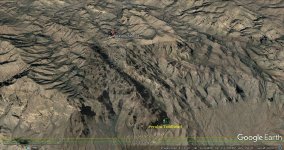
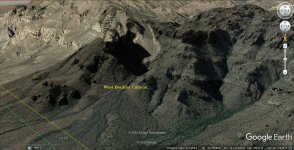
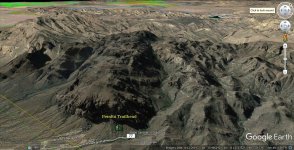
I describe the Ortiz Letter as "ambiguous" because its wording is so vague that it can be taken to have more than one meaning. It does not provide complete and accurate directions to find a mine site, and thus, fails to fulfill its intended purpose. I would guess that it was written by a prankster sometime after Bicknell's newspaper article was published. It's similar enough to Bicknell's article, and adds some tantalizing details (probably fictional), so I'll use it alone, as a guide, to warrant selling all my worldly belongings, using the money to pack my burros, and spend the rest of my life searching for the Lost Dutchman Mine. The Ortiz Letter reads as follows:
"... first go to tordis mountain, then south side go eastward until you find the first gorge on the south side from the west end follow the gorge until you find another trail which will lead you northwards over a lofty ridge then downwards past hidden needle to a long canyon and then east to a tributary canyon about 35-40 meters from the end after you find the mine destroy ..."
For comparison, Bicknell's 1895 newspaper article uses this wording:
"... The mine lies within an imaginary circle, whose diameter is not more than 5 miles, and whose center is marked by the Weaver's Needle, which is about 2,500 feet higher, among a confusion of lesser peaks and mountain masses of basaltic rock. The first gorge on the south side from the west end of the range. They found a monumental trail which lead them northward past Sombrero Butte into a long canyon. Travel northward in the gorge and up over a lofty ridge, thence downward past the Needle into a canyon running north, and finally into a tributary canyon, very steep and rocky, and densely wooded with a continuous thicket of scrub oak."
Notice that the word "lofty" is used in both sources. It is more of a journalist's word than what would be expected from a Mexican man struggling to write in the English language. So, that fact alone gives me ample proof that most of the Ortiz Letter is "borrowed" from Bicknell's article.
With only the Ortiz Letter in mind, however, my route to the vicinity of the mine begins at "the first gorge on the south side from the west end," which is the gorge where West Boulder Trail begins. I see Peralta Trail beginning at the second gorge on the south side from the west end. I also like beginning at West Boulder Trail, rather than Peralta Trail, because when old man Ruth asked if there was a pinnacle nearby he was taken up West Boulder Trail to Willow Spring by the two cowboys. Ruth seem to be fixated on Weaver's Needle as a vital landmark, just as it is in the Ortiz Letter (hidden needle).
My route follows West Boulder Trail only part way, then makes a detour that can be justified by one essential reason. The reason for the detour is to gain elevation, and to put Weaver's Needle in sight. It's the landmark that will be used as a guidepost -- a vital reference point. Part Two will continue with "... another trail which will lead you northwards over a lofty ridge ..."





